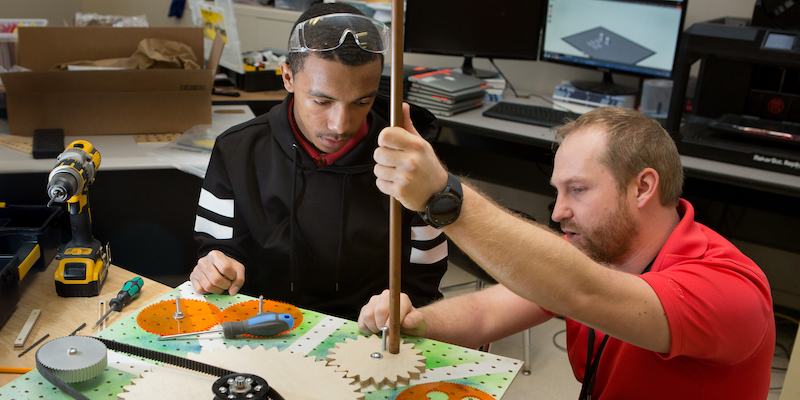The events of the last few weeks have brought the issue of racial justice for Black Americans front and center in our national and global conscientiousness. Although issues of education are not the central focus of protest signs on the streets, they are, nonetheless, critical as we consider how innovation in education has the potential to enable a more equitable and just future, especially for Black students and others whom our education system has underserved. If educators’ work is ultimately about the good of society, it is important to consider whether that work leads to good things for all groups within our society.
Disruptive Innovation expands access, affordability, and customization
Our mission statement at the Christensen Institute affirms that we are “dedicated to improving the world through Disruptive Innovation.” So how can Disruptive Innovation fulfill this mission? It makes life-improving technologies more accessible, affordable, and customizable—and in doing so frequently addresses the unmet needs of people without another option. For example, disruption in the auto industry vastly expanded access to individual transportation by lowering the cost of car ownership. Similarly, disruption in computing brought the power of complex, multi-million dollar machines to cheap handheld devices that people from nearly all walks of life now carry in their pockets. Furthermore, mobile devices have dramatically expanded access to services ranging from banking for Kenyans to telemedicine for rural communities.
Nonetheless, reducing inequity is a side-effect of disruption, not its purpose. Like the law of gravity, disruption is a natural phenomenon that is agnostic to societal inequities. This means that in some instances it can also have no impact on inequities, or even exacerbate them. For example, even as disruptions make life-changing innovations more accessible and affordable, they may still remain out of reach to some populations. Additionally, expanded access does not mean equal access to quality—access to mobile banking doesn’t provide financial literacy skills or access to financial services that help people build wealth. Lastly, although disruptive innovations expand access to goods and services, their side effects can sometimes negatively impact communities in other ways. Many disruptive innovations expand employment by growing new enterprises to serve new markets, yet some reduce employment by displacing incumbent companies with less labor-intensive competitors.
Blended learning’s impact on equity in education
One particular disruptive innovation relevant to our work in education is blended learning—the incorporation of online learning into brick-and-mortar school settings. Blended learning can, in principle, help schools to overcome the inherent inequities of conventional instruction. The batch-processing foundations of conventional instruction are ill-suited to the reality that students are not all the same. In contrast, blended learning can expand teachers’ capacities to tailor educational experiences to students’ unique needs so each can reach their full potential. This student-centered approach is especially important in schools that serve historically underserved students given how students’ identities and circumstances outside of school shape their learning needs.
Blended learning can also be a tool for equity in changing the power dynamic and relationships and between teachers and students—which is especially important when a still largely white teaching force is responsible for educating an increasingly diverse student body. Conventional instruction expects students to conform their needs and interests to prescribed whole-group learning activities. As a result, many teachers often turn to command-and-control approaches to classroom management in order to ensure students learn. In contrast, the more blended learning is used to shift away from whole-group, teacher-directed instruction, the more it reduces the need for teachers to control students. This, in turn, creates more opportunities for teachers and students to build positive, meaningful relationships through one-on-one interactions. The more students and teachers can build relationships on care and trust—rather than obedience to authority—the more students of color will be heard, and the more teachers will bring empathy and understanding to those relationships.
Yet, blended learning is not inherently more equitable than conventional instruction. Although blended learning can power student-centered learning, not all blended learning is student-centered. Blended-learning models evolve to address the problems we implement them to solve, and, in fact, sometimes this responsiveness to demand can steer them away from addressing inequity. For example, if schools adopt blended learning primarily to enable larger class sizes or give students an easy way to make up credits, the model will do what it’s designed for—which could easily preserve or even exacerbate inequities. Additionally, even when blended learning is used to make learning more student-centered, improvements for some students do not necessarily translate to improvements for all students. If student-centered learning models are not formed with equitable designs woven throughout, they may continue to allow students on the margins to slip through the cracks.
Ensuring that innovations improve equity
In sum, disruptive innovations can be a powerful lever for driving greater equity in education and beyond, but equity is not something they guarantee. Innovations are shaped by people who invent, develop, produce, and adopt them. Thus, to ensure that the arc of innovation bends toward equity, all of us whose actions and choices influence innovation need to be ever mindful of whether we are steering innovations toward equity, or maintaining the status quo.
Photo courtesy of Allison Shelley/The Verbatim Agency for American Education: Images of Teachers and Students in Action.


